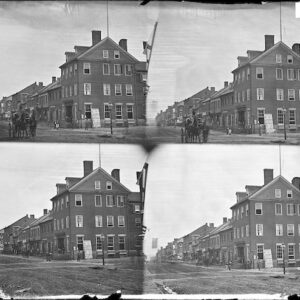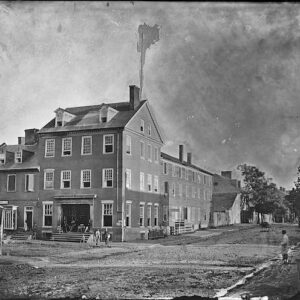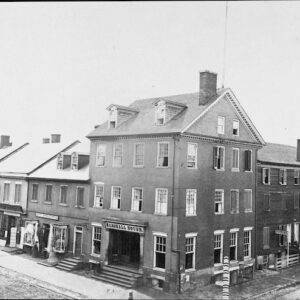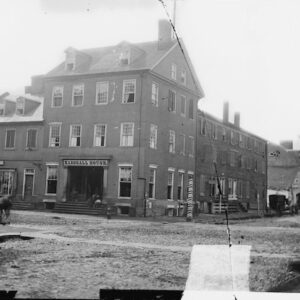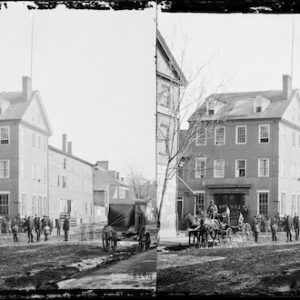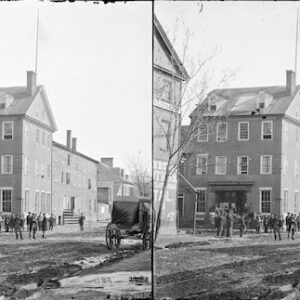Tag: Marshall House (Alexandria VA)
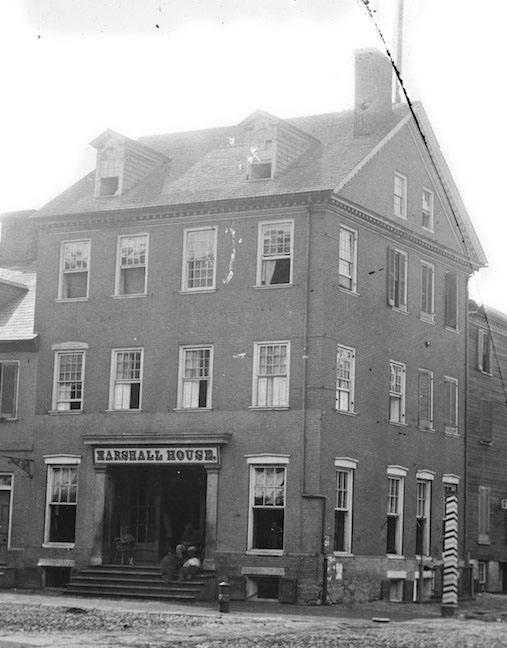 Wikipedia says: The Marshall House was an inn that stood at 480 King Street (near the southeast corner of King Street and South Pitt Street) in Alexandria, Virginia. At the beginning of the American Civil War in 1861, the house was the site of the killing of Col. Elmer E. Ellsworth during the Union Army’s takeover of Alexandria. Ellsworth was a popular and highly prominent officer and a close friend of President Abraham Lincoln.
Wikipedia says: The Marshall House was an inn that stood at 480 King Street (near the southeast corner of King Street and South Pitt Street) in Alexandria, Virginia. At the beginning of the American Civil War in 1861, the house was the site of the killing of Col. Elmer E. Ellsworth during the Union Army’s takeover of Alexandria. Ellsworth was a popular and highly prominent officer and a close friend of President Abraham Lincoln.
Ellsworth was the first conspicuous Union Army casualty and the first officer killed in battle during the war. He was shot by the inn’s proprietor James W. Jackson after removing a Confederate flag from the roof of the inn. Jackson was immediately killed after he killed Ellsworth. Ellsworth’s death became a cause célèbre for the Union, while Jackson’s death became the same for the Confederacy.
Ellsworth, a young Illinois lawyer who was a friend of the Lincoln’s and founder of the 11th New York Volunteer Infantry Regiment known as the “Fire Zouaves”, was killed at the Marshall House on May 24, 1861 (the day after Virginia’s secession was ratified by referendum) during the Union Army’s take-over of Alexandria. During the month before the event, the inn’s proprietor, James W. Jackson, had raised from the inn’s roof a large Confederate flag that President Lincoln and his Cabinet had reportedly observed through field glasses from an elevated spot in Washington. Jackson had reportedly stated that the flag would only be taken down “over his dead body”.
Before crossing the Potomac River to take Alexandria, soldiers serving under Ellsworth’s command observed the flag from their camp through field glasses and volunteered to remove it. Having seen the flag after landing in Alexandria, Ellsworth and seven other soldiers entered the inn through an open door. Once inside, they encountered a man dressed in a shirt and trousers, of whom Ellsworth demanded what sort of a flag it was that hung upon the roof.
The man, who seemed greatly alarmed, declared he knew nothing of it, and that he was only a boarder there. Without questioning him further, Ellsworth sprang up the stairs followed by his soldiers, climbed to the roof on a ladder and cut down the flag with a soldier’s knife. The soldiers turned to descend, with Private Francis E. Brownell leading the way and Ellsworth following with the flag.
As Brownell reached the first landing place, Jackson jumped from a dark passage, leveled a double-barreled gun at Ellsworth’s chest and discharged one barrel directly into Ellsworth’s chest, killing him instantly. Jackson then discharged the other barrel at Brownell, but missed his target. Brownell’s gun simultaneously shot, hitting Jackson in the middle of his face. Before Jackson dropped, Brownell repeatedly thrust his bayonet through Jackson’s body, sending Jackson’s corpse down the stairs.
Ellsworth became the first Union officer to die while on duty in the Civil War. Brownell, who retained a piece of the flag, was later awarded a Medal of Honor for his actions.
Ellsworth’s body was taken back across the Potomac to Washington, D.C. and was laid in state in the East Room at the White House. Immediately after the incident, thousands of Union supporters rallied around Ellsworth’s cause and enlisted, and “Remember Ellsworth” became a patriotic slogan. The 44th New York Volunteer Infantry Regiment called itself the “Ellsworth Avengers” as well as “The People’s Ellsworth Regiment”. Confederates meanwhile hailed Jackson as a martyr to their cause.
Soldiers and souvenir hunters carried away pieces of the flag and inn as mementos, especially portions of the inn’s stairway, balustrades and oilcloth floor covering. After the war ended, the Marshall House served as a location for a series of small businesses, but still attracted tourists from both the North and the South. Largely reconstructed after an 1873 fire that an arsonist caused, the building was torn down around 1950.
The City of Alexandria has erected a wayfinding sign near the southeast corner of King Street and South Pitt Street. The sign relates the history and significance of the Marshall House, together with historical photographs and other information.
